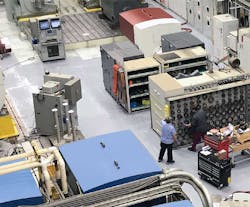Siemens Updates Motor Testing Capabilities for Industry 4.0
“Knowledge is power,” goes the old adage, but at the front line of manufacturing today “power” is becoming more knowledgeable. That is the effect of digital manufacturing and Industry 4.0 initiatives, in which every operating unit is expected to be a connected device. Not the least part of this vision is bringing old-style mechanical motors (which power much of the activity in machine shops) in line with the latest capabilities.
Thus it is that Siemens Corp. undertook to modernize its 120-year-old motor-manufacturing operation near Cincinnati. The Norwood Motor Manufacturing plant recently opened a new test observatory, a two-year construction and improvement program that include installing new, 360-ton motor test stand.
“At Norwood, we test every motor that we produce or repair – some 30 to 50 tests per week – and these new facilities give us the ability to conduct as many as five motor tests at a time.” stated Tim Bleidorn, manager, Manufacturing Excellence. “We expect the customer witness tests to average two to three per week, and as many as 120 per year.”
The project involved removing 550 tons of soil and concrete from the site, excavating a 13-ft-deep hole, driving 114 pilings, and installing a giant concrete vault to support a fully loaded, 360-ton test stand. The test stand rests on a self-leveling air-spring system designed to support 500 tons when fully loaded with motors and drives.
It includes two Sinamics Perfect Harmony GH180 drives and two dynamometers. But, as Siemens noted, generating power to test a 20,000-HP motor requires significant amounts of electricity; by recycling power to the grid, the new equipment reduces power loss by 90%.
Other Norwood improvements include a WFL Millturn Technology high-precision shaft grinding machine and a high-speed balancer, used in balancing two-pole high-speed rotors at up to 12,000 rpm.
The new equipment expands Norwood’s testing range from 10,000 horsepower (HP) to 20,000 HP, and frequencies from 10 to 300 Hz. This means Siemens is more available to test variable-frequency drives.
Last, Siemens new Norwood test observatory allows customers to participate in the testing process by observing through bay windows, direct cameras, and mirroring computers that display critical data in real time as it is gathered by sensors attached to a motor being tested.
